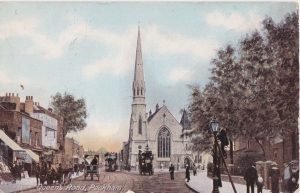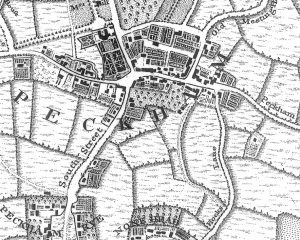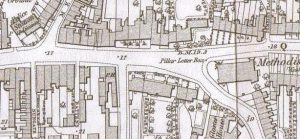ln the early years of the 20th century, postcard manufacturing companies recorded many local scenes for family correspondence. One of Queens Road shows in the centre the 1865 Wesleyan Church (its spire a dominating feature of the local scene), to the left a horse-drawn dray and to the right a coach with bonneted ladies on top and a tram approaching. In the foreground on this side, a lamp-lighter is adjusting a street light. In a black and white version of the scene, the old London plane trees before the house are bare. There is a coloured version of the identical picture with foliage painted in.

Opposite the lower numbers on the east side of Consort Road stood a group of wooden cottages which belonged to the rural era of the place. By legend they had been those of grooms working at the larger local houses. To make way for a new clearance scheme extending west to Rye Lane, the houses were pulled down in 1962. The South London Press of 12 January 1962 featured the “last of the old wooden cottages”, with Will Green’s photograph of two of the last residents emerging.
Maps
The house and two others (Nos. 6 and 8) appear on J. Rocque’s map of 1746, which was dedicated to Baron Boyle, Viscount Dungarven. The three structures, with rear gardens and fields, lie between Hock’s Lane to the east and, on the opposite side of the main road, Old Meeting House Lane to the west. The main road is then Peckham Lane, later part of the High Street, and later Queen’s Road. The map shows the future Rye Lane as South Street; but Peckham Rye Common and Goose Green are featured. To the south lies Nun Head and east of it Plow’d Garlick Hill (now Telegraph Hill Park). Eastward, open fields extend to the settlements around New Cross; the future Old Kent Road (the Dover Road) following its historic course to Black Boy Lane, Halfway House, North Peckham and the Hen and Chickens.
Deeds
The deed of 5 October 1843 between Robert Emmett and William Lowless refers to “the old house” as “Lemon House, situated on the South side of the High Street in the County of Surrey.” The original linen map of the Emmett property of that date can be seen in Southwark Local History Library. The holding included Cow Walk (later Albert, then Consort Road), a private path to the Cow Field, for the use of which the tenant of the Cow Public House paid one guinea per year.
The transaction recorded is essentially that of an 80 year building or development lease, citing the properties which could be erected, and stipulating the care of the house. The deed specifically refers to buildings in front of the old house, which clearly was not done. However, the houses on Consort Road (Nos. 1-15) were later built on this property. Perhaps the reference is to No. 2 Queen’s Road because the Abstract of Title now shows a new freehold dwelling adjacent to No. 4.
The Abstract records that Robert Emmett by his will of 15 May 1849, devised his widow and brothers-in-law (Chauntler) as his executors. He died on 5 May 1852, the will being legally acknowledged in the Prerogative Court of Canterbury.
At his widow’s death, on 30 December 1891, the house, under the same name, still described as in the County of Surrey, goes to James Washington Crouch. The property attached to Lemon House includes at the rear a yard, field and paddock, stables and a coach-house. On Albert Road, on the left side, Nos. 1,3,5,7,9,11,13 and 15 had by then been constructed.
These historic deeds and map are referred to in, and accompanied, the title deed of 30 September 1922 (lodged 10 October 1922 at Somerset House) on the sale of Nos. 2 and 4 by George Chauntler Emmett, Esquire of that address, to our predecessor Robert Govan MB, Esquire.
The documents came into my possession via my then medical partner, George J. Arendt. He received them when our immediate predecessor and briefly senior partner, Captain E. Gilbert (RAMC, retired), who had been appointed to the Peckham practice by the London Executive Council on Dr Govan’s death, moved to the Home Counties.
####PIC The old houses in Queen’s Road
The House in 1957
ln 1957 a cobbled way still extended from the street to the old stable, set between the main structure of the house and the Peckham Permanent Building Society next door. This, in the 1920s became the garage as Dr Govan abandoned the horse-drawn vehicle for the internal combustion engine. The driver became the chauffeur. Above the green gates of the garage, a green door on the floor above admitted straw bales to the loft, where the drivers son (later the practice medicine boy) slept at night, to assist in the event of night calls. The doctor’s practice extended as far as the West End.
Within, on the ground floor, at the garden end, two stalls were still standing. its floor was also cobbled. In the Danish architect’s plan these areas became the kitchen and dining room of 4b Queen’s Road and the loft above a bedroom.
6 Queen’s Road
No. 6 Queen’s Road was thought to be of slightly greater antiquity than No. 4. There were all kinds of stories related about it: of a ghost and even of a connection with Nell Gwyn.
A forward extension of the ground floor was the office of the Peckham Permanent Building Society. On the first floor, it was claimed, lived a reclusive individual. One night in the very early years of our residence (1957 to 1978) we woke to smoke, flames and alarms, then the Fire Brigade. The tenant had accidentally set off a fire. I think there was one casualty. The then manager of the PPBS informed us that the fire had destroyed a fully panelled room beyond restoration.

1871 map of Queen’s Road
Beyond this building were two other old dwellings. A Georgian house with a circular drive, reproduced on old maps, was used by a vat maker (Carty’s), whose secretary showed me a dossier of the house development in Consort Road, of the erection on Numbers 1-15; No. 15 on the corner of Consort and Harders Roads, being the house and lovely garden of the Medicine Boy.
One of the houses to the East was, in 1957, a sauce and pickle manufacturer (possibly Escoffier, or some such French name). On certain days the area was pervaded by a not unpleasant, sweet vinegary odour.
Dr Tom Madden
Reprinted from Peckham Society News, Issue 118 (Winter 2009)


